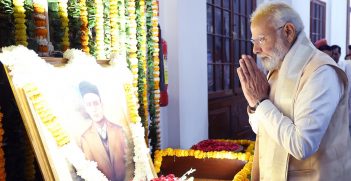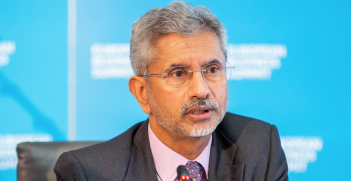76 Years of Strained Relations Between India and Pakistan Over Kashmir

Following the partition of the Indian subcontinent in 1947, India and Pakistan have fought three major wars over 70 years. The use of communication technologies to exacerbate instability has altered the dynamics of the region’s conflict in recent years.
India and Pakistan have been embroiled in a relationship of mutual animosity since their independence as new nations in 1947. When British rule partitioned the Indian subcontinent, India opted to be a secular country while Pakistan was created as a country for Muslim majority peoples on the subcontinent. A proposal was agreed to at the time where Hindus or Muslims living in either India or Pakistan were allowed to leave their homes and decide on which country they wanted to live. Over 17 million people left their homes in one of the largest exchanges of population in history. The sudden partition created an atmosphere of suspicion and hostility in the areas where migration took place. Consequently, the forced displacement resulted in violence that left more than a million people dead.
The region of Jammu and Kashmir was an anomaly in the logic of the partition because it was a Muslim-majority state governed by a Hindu ruler. The Maharaja, Hari Singh, was indecisive about merging Kashmir with India or Pakistan, or keeping the region independent. This changed when Pakistan raiders infiltrated Kashmir in October 1947, forcing the ruler to appeal to the then prime minister of India, Jawaharlal Nehru. This resulted in Kashmir being acceded under the Indian Constitution. The Indian army thwarted the advance of the Pakistan raiders into Kashmir after the Maharaja signed an Instrument of Accession with India in October 1947.
India then sought international intervention at the United Nations (UN) in 1948. The UN Security Council (UNSC) adopted a three-part resolution and unanimously passed Resolution 47. Part one dealt with the ceasefire, whereas part two and part three dealt with a truce agreement, and entering into consultations with the commission for deciding the future of Kashmir. The UNSC Resolution 47 call for a referendum was conditional on Pakistan’s concession to vacate the Kashmir region. In 1949, the ceasefire agreement came into effect. By that point, Pakistan had already infiltrated one-third of Kashmir. Since then, Pakistan has administered the regions of Giljit-Balistan and Azad Kashmir, which are now referred to collectively as PoK (Pakistan Occupied Kashmir).
According to a study published in 2017 by the European Foundation For South Asian Studies, young people represent more than 50 percent of Kashmir’s population, and this segment of the population have been persuaded to believe that the world’s Muslim population are fighting for Kashmir’s independence from India. These events have led young Kashmiris to misuse communication technologies, for example, to attract young recruits. Young, self-styled militants have released pictures and videos on social media portraying themselves as warriors with weapons in hand, glorifying militancy.
These protests to regain Kashmir’s independence began with violence in 2010. Following the death of a Kashmiri schoolboy, who was allegedly killed in a tear-gas shelling by the security forces, a widespread protest erupted with locals engaged in stone-pelting government forces. Protests were legitimised as a vent for the youths to display their spirit of anger and freedom against the government. The protests that followed from 2010 to 2016 resulted in over 100 people dead and 600 civilians injured. An Indian news report revealed in 2017 that nearly 300 WhatsApp groups were employed, in the lead up to the first protests in 2010, to mobilise the people and encourage the stone pelting.
Without a clear pathway for peace, the logical extension of the protests has been greater violence. Most recently in 2019, Jaish-e-Mohammad, a Pakistan based militant group active in Kashmir, planned and executed an attack on an Indian convoy carrying military personnel. The execution resulted in the killing over 40 Central Reserve Police Force (CRPF) in Kashmir’s Lethopora.
The Bharathiya Janata Party (BJP) government has proactively used these terrorist attacks as an opportunity to redefine Kashmir’s status. On 5 August 2019, the Narendra Modi government annexed Kashmir into the Indian Constitution, abrogating both Article 35(A) and Article 370. Article 35(A) is defined by the Indian Constitution as privileges to the Kashmiri people such as the right to purchase land, vote or contest elections, seek government employment, and other state benefits, including healthcare and education, which are not granted to other non-permanent residents of the state.
The annexation of Kashmir into the Indian Constitution has been criticised by scholars, arguing that the removal of Kashmir’s special status would allow non-Kashmiri people to buy land and migrate to it. On 5 August 2022, the Pakistan High Commission Pretoria conducted a seminar to mark Youm-e-Istehsal (Exploitation Day) for India’s abrogation of Kashmir’s special status.
Over the years, there have been sporadic attempts to resolve the Kashmir dispute through bilateral talks, mediation efforts by international actors, and confidence building efforts. However, these efforts have been marred by mistrust, political challenges, and differing positions on key issues such as water disputes and territorial claims. The lack of progress in finding a mutually acceptable solution on Kashmir has perpetuated tensions in younger generations willing to participate in terrorist activities along the Line of Control. The Indian government has found ways to curb internal conflict by shutting down the Internet. The best example was during the protest that erupted after abrogating Kashmir’s special status, but a comprehensive and a long lasting resolution to the conflict in Kashmir remains elusive.
Siddharth Senthil Kumar is currently pursuing a Master’s degree in International Relations and Journalism at Monash University. His fields of interest include contemporary security issues in Southeast Asia, Indian political history, and journalism.
This article is published under a Creative Commons Licence and may be republished with attribution.





